
If you’re reading this and it’s in the heart of summer, chances are there is some extreme heat in your area. Staying hydrated in extreme heat can be very challenging, especially for kids who are engaged in sports. An understanding of what can go wrong is crucial to making sure you are hydrating your kids properly during the summer.
How Hot is Too Hot?
There’s no good answer to this, because each geographical area is different. As the weather starts heating up after Spring season, 80°F may feel really hot, however, in mid-July in much of the United States, 80°F would sound like a dream — as temperatures reach into the 90’s and beyond.
When you factor in humidity, you start talking about dangerous heat. You no longer just consider the temperature that your thermometer (or your watch for those that aren’t living in 1982) tells you, you need to look at heat index, or what the temperature feels like with humidity. That’s when you can start getting into the danger zone when exercising in the heat.
Humidity is Air You Can Wear
Humidity is the worst. It makes hair look terrible, forget about wearing make-up, and it’s downright dangerous for athletes. When humidity levels rise, combined with rising temperatures, you get a heat index — which is the “feels like” temperature.
Why is a rising heat index harmful for athletes? When the temperature rises, the body sweats for the purpose of cooling off = lower body temperature. When the temperature and humidity are low, sweat evaporates and helps with the cooling process.
When humidity rises, sweat does not easily evaporate, which means the body’s temperature continues to rise. This is extremely dangerous for active kids who may be at the mercy of a coach for water breaks, and do not know the signs of heat stroke or heat exhaustion.

Heat Exhaustion vs. Heat Stroke
When temperature, humidity, and/or heat index rise, the risk for heat illness increases significantly. Coaches, parents, and kids themselves need to know the warning signs and how to hydrate properly to help prevent an emergency. Note that the signs/symptoms listed below may not be all-encompassing, and some, all, or none may be present.
| Heat Exhaustion | Heat Stroke |
| Heavy Sweating Dizziness Cramping Nausea Headache Fainting | Stop sweating Very high body temperature Dizziness Confusion Loss of consciousness |
Both heat exhaustion and heat stroke are dangerous, but heat stroke is a medical emergency. For more information, see the CDC’s website.
Staying Hydrated in Extreme Heat
Parents, coaches, and teen athletes need to be prepared — and that means planning. Having a plan will help you feel in control and provide the help needed should an emergency arise.
Know the Weather
First things first, know what the heat index is going to be for the day. If a child is going to be out in the heat and humidity any longer than one hour, you need more than water. A sports drink is a good choice, because it will provide electrolytes lost in sweat. I always go for the full calorie sports drinks and not the zero sugar. If my kid is drinking a sports drink, you better believe they are actually playing sports, that means they need energy replacement as well. Sports drinks are for individuals participating in an activity, not for leisurely drinking on a Tuesday.
Keep it Cold
As the body temperature rises, you want to drink something that will help bring it down. If you have a cooler, bring it to keep hydration cold. Better yet, pack some ice packs in the event that someone suffers a heat emergency or an injury.
Pack a Variety of Fluids
It’s always a good idea to bring water, plus something else (sports drink, hydration beverage, electrolyte powders, etc). The heat can do funny things to a digestive system and not all fluids may be tolerated well. Better to have options.
Parent and Coaches: Never make kids “chug” drinks thinking it will hydrate them faster. Trust their thirst and encourage them to drink. Drinking too many fluids in a short amount of time can result in water intoxication.
Different Hydration Choices
| Hydration Choice | Good For… |
| Water | Exercise that lasts less than 60 minutes in cooler weather with low levels of humidity. |
| Sports Drink (Gatorade, Powerade) | Exercise that lasts longer than 60 minutes, or if a child is exercising in hot and humid conditions with heavy sweating. |
| Hydration Drinks (Body Armor, PRIME, Vitamin Water) | Purely hydration. These hydration drinks are typically low in calories and sodium. |
| Electrolyte Powders | Mixing with water to make your own sports drink – choose one with sugar rather than a no-calorie sweetener for sports. |
| Coffee, Energy Drinks, Sweet Tea | NOT good for sports – caffeine is not recommended, as it may cause mild dehydration. |


